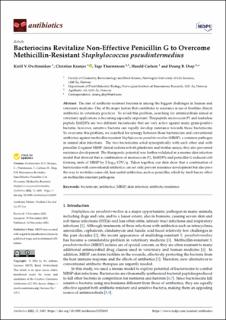| dc.contributor.author | Ovchinnikov, Kirill | |
| dc.contributor.author | Kranjec, Christian | |
| dc.contributor.author | Thorstensen, Tage | |
| dc.contributor.author | Carlsen, Harald | |
| dc.contributor.author | Diep, Dzung B. | |
| dc.date.accessioned | 2022-12-27T14:04:41Z | |
| dc.date.available | 2022-12-27T14:04:41Z | |
| dc.date.created | 2022-11-30T16:44:06Z | |
| dc.date.issued | 2022-11-24 | |
| dc.identifier.citation | Antibiotics. 2022, 11 (12), 1-13. | en_US |
| dc.identifier.issn | 2079-6382 | |
| dc.identifier.uri | https://hdl.handle.net/11250/3039574 | |
| dc.description.abstract | The rise of antibiotic-resistant bacteria is among the biggest challenges in human and veterinary medicine. One of the major factors that contributes to resistance is use of frontline clinical antibiotics in veterinary practices. To avoid this problem, searching for antimicrobials aimed at veterinary applications is becoming especially important. Thiopeptide micrococcin P1 and leaderless peptide EntEJ97s are two different bacteriocins that are very active against many gram-positive bacteria; however, sensitive bacteria can rapidly develop resistance towards those bacteriocins. To overcome this problem, we searched for synergy between those bacteriocins and conventional antibiotics against methicillin-resistant Staphylococcus pseudintermedius (MRSP): a common pathogen in animal skin infections. The two bacteriocins acted synergistically with each other and with penicillin G against MRSP clinical isolates in both planktonic and biofilm assays; they also prevented resistance development. The therapeutic potential was further validated in a murine skin infection model that showed that a combination of micrococcin P1, EntEJ97s and penicillin G reduced cell-forming units of MRSP by 2-log10 CFU/g. Taken together, our data show that a combination of bacteriocins with conventional antibiotics can not only prevent resistance development but also pave the way to revitalize some old, less useful antibiotics, such as penicillin, which by itself has no effect on methicillin-resistant pathogens. | en_US |
| dc.language.iso | eng | en_US |
| dc.publisher | MDPI | en_US |
| dc.rights | Navngivelse 4.0 Internasjonal | * |
| dc.rights.uri | http://creativecommons.org/licenses/by/4.0/deed.no | * |
| dc.title | Bacteriocins Revitalize Non-Effective Penicillin G to Overcome Methicillin-Resistant Staphylococcus pseudintermedius | en_US |
| dc.title.alternative | Bacteriocins Revitalize Non-Effective Penicillin G to Overcome Methicillin-Resistant Staphylococcus pseudintermedius | en_US |
| dc.type | Peer reviewed | en_US |
| dc.type | Journal article | en_US |
| dc.description.version | publishedVersion | en_US |
| dc.rights.holder | © 2022 by the authors | en_US |
| dc.source.pagenumber | 1-13 | en_US |
| dc.source.volume | 11 | en_US |
| dc.source.journal | Antibiotics | en_US |
| dc.source.issue | 12 | en_US |
| dc.identifier.doi | 10.3390/antibiotics11121691 | |
| dc.identifier.cristin | 2086239 | |
| dc.relation.project | Norges forskningsråd: 275190 | en_US |
| dc.relation.project | Norges forskningsråd: 296220 | en_US |
| dc.relation.project | Norges forskningsråd: 273646 | en_US |
| dc.source.articlenumber | 1691 | en_US |
| cristin.ispublished | true | |
| cristin.fulltext | original | |
| cristin.qualitycode | 1 | |

